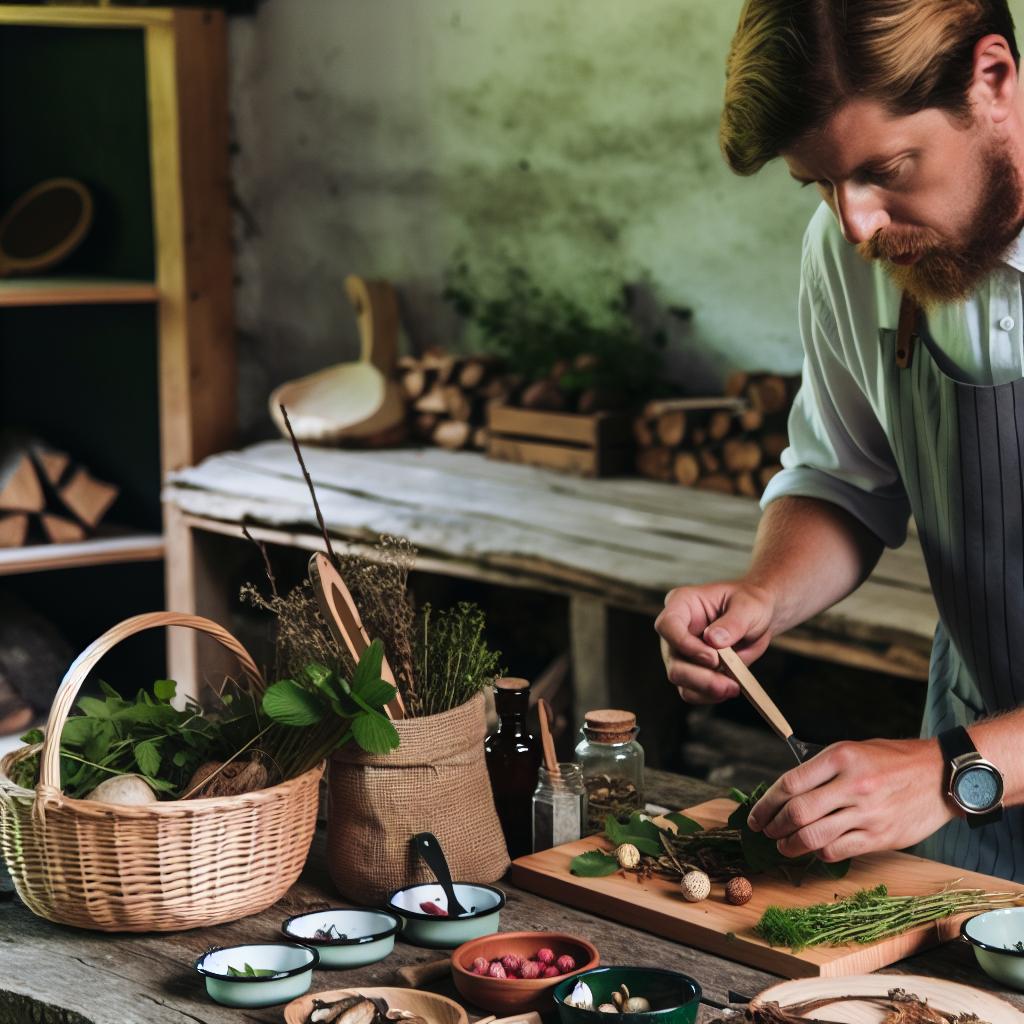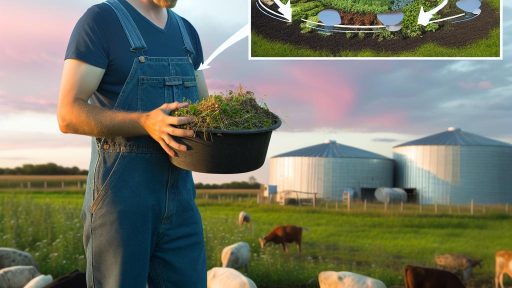Introduction to Artisanal Food Production
Artisanal food production emphasizes traditional methods and quality ingredients.
This practice resonates with consumers seeking unique flavors and authenticity.
Artisanal producers often rely on wildcrafted and foraged ingredients.
Such ingredients enhance the uniqueness and flavor of their products.
Understanding Artisanal Techniques
Producers use time-honored techniques to create exceptional foods.
These methods include fermentation, curing, and small-batch cooking.
Each technique requires skill and knowledge to execute properly.
Moreover, attention to detail elevates the final product.
The Role of Wildcrafted and Foraged Ingredients
Wildcrafted and foraged ingredients add depth to artisanal foods.
These ingredients connect consumers with nature and local ecosystems.
Foraging encourages sustainable harvesting practices among producers.
It fosters respect for the environment and biodiversity.
Benefits of Artisanal Food Production
Artisanal food production supports local economies and communities.
It often relies on nearby farms and local suppliers for ingredients.
Additionally, this approach promotes transparency in food sourcing.
Transform Your Agribusiness
Unlock your farm's potential with expert advice tailored to your needs. Get actionable steps that drive real results.
Get StartedConsumers appreciate knowing where their food originates.
Challenges Faced by Artisanal Producers
Artisanal producers encounter various challenges in their practice.
These include sourcing consistent quality from wildcrafted ingredients.
Furthermore, regulations can complicate small-scale operations.
Producers must navigate certifications and compliance standards.
Artisanal Food Production Enriches Culinary Experience
Artisanal food production offers many advantages.
Wildcrafted and foraged ingredients play a vital role in this process.
Ultimately, this practice enriches our culinary experiences.
As consumers, we can support local artisans and their unique offerings.
Understanding Wildcrafted Ingredients
Definition of Wildcrafted Ingredients
Wildcrafted ingredients come directly from nature.
They are collected from their natural habitats.
This process requires knowledge of local ecosystems.
Wildcrafting emphasizes sustainability and respect for the environment.
This approach allows chefs and food producers to use unique flavors.
Benefits of Using Wildcrafted Ingredients
Using wildcrafted ingredients offers numerous advantages.
First, they provide distinct flavors that enhance culinary creations.
Second, these ingredients promote biodiversity in local ecosystems.
Additionally, wildcrafted foods often contain higher nutrient levels.
They also foster a connection between people and nature.
By sourcing locally, producers support regional economies.
Challenges in Wildcrafting
While wildcrafting has benefits, it also presents challenges.
For instance, identifying safe and edible plants is crucial.
Additionally, overharvesting can threaten wild populations.
Furthermore, regulations may restrict the harvest of certain species.
Showcase Your Farming Business
Publish your professional farming services profile on our blog for a one-time fee of $200 and reach a dedicated audience of farmers and agribusiness owners.
Publish Your ProfileBalanced practices ensure the sustainability of wildcrafted ingredients.
Wildcrafting Techniques
Several techniques can aid in the wildcrafting process.
First, understanding seasonal growth patterns is important.
Harvesting at the right time maximizes flavor and nutritional value.
Second, using sustainable harvesting methods is essential.
This practice can include selective picking to preserve plants.
Lastly, knowledge of local regulations ensures compliance.
The Art of Foraging: Techniques and Ethical Considerations
Understanding Foraging
Foraging connects people to nature’s resources.
It provides fresh ingredients while promoting sustainability.
Moreover, foragers learn about local ecosystems.
Foraging Techniques
Start by identifying edible plants in your area.
Use reliable field guides and apps to aid recognition.
Additionally, join foraging classes for hands-on experience.
While out, observe plant habitats and growing conditions.
Use caution when foraging around urban environments.
Ethical Considerations
Foraging requires responsibility and respect for nature.
Always follow the rule of thumb: take only what you need.
Additionally, leave enough for wildlife and future growth.
Furthermore, avoid overharvesting any single species.
Be aware of local regulations regarding foraging.
Safety First
Know how to identify poisonous plants to avoid accidents.
Always wash foraged items to remove contaminants.
Be cautious of foraging near roads or polluted areas.
Finally, consult experts when unsure about an item.
Discover More: Farm-To-Table Events for Supporting Farm Cooperatives and Rural Growth
Seasonality and Sustainability in Artisanal Food Making
The Importance of Seasonality
Artisanal food production thrives on seasonality.
Using seasonal ingredients enhances flavor and freshness.
Moreover, it reflects the natural rhythms of our environment.
Cooking with seasonal produce supports local farms.
Additionally, it helps reduce the carbon footprint of transportation.
Sourcing Wildcrafted Ingredients
Wildcrafted ingredients add unique flavors to dishes.
Foraging connects us with nature and its bounty.
However, it’s essential to practice sustainable foraging.
Respect for the ecosystem ensures we preserve these resources.
Educating foragers about local plants cultivates responsible harvesting.
Supporting Local Communities
Sourcing from local producers strengthens community ties.
It helps local economies thrive and fosters relationships.
Furthermore, buying local reduces transportation emissions.
Consumers benefit from fresher, higher-quality ingredients.
Making Sustainable Choices
Choosing sustainable practices benefits the environment.
Showcase Your Farming Business
Publish your professional farming services profile on our blog for a one-time fee of $200 and reach a dedicated audience of farmers and agribusiness owners.
Publish Your ProfileFor instance, reducing waste in food production is crucial.
Composting scraps can enrich soil health and reduce landfill use.
Additionally, using eco-friendly packaging is increasingly important.
Balancing Tradition and Innovation
Artisanal food production merges tradition with innovation.
Innovation can lead to new flavor combinations and techniques.
Respecting traditional methods honors cultural heritage.
Striking this balance enriches the culinary landscape.
Understanding Consumer Impact
Consumers play a vital role in sustainable food systems.
Making informed choices encourages responsible production.
Moreover, supporting brands with sustainable practices promotes change.
As a result, consumer demand can influence industry standards positively.
Delve into the Subject: Permaculture Practices for Enhancing Biodiversity on Farmlands
Preservation Methods for Wildcrafted Ingredients
Introduction to Preservation
Preservation extends the life of wildcrafted ingredients.
Using various methods, we maintain their flavor and nutrients.
These techniques help minimize waste and enhance sustainability.
Drying Techniques
Drying is a popular preservation method.
This technique removes moisture, inhibiting microbial growth.
Sun drying is a traditional method.
It requires warm, dry weather and ample sunlight.
Oven drying offers a controlled environment.
Use low temperatures to preserve flavors effectively.
Dehydrators are another efficient option.
They provide consistent heat and airflow.
Curing and Fermentation
Curing adds flavor while preserving ingredients.
This technique involves salt, sugar, or other preservatives.
Fermentation enhances nutrient availability and flavor complexity.
This process relies on microorganisms to transform ingredients.
Kefir from wildcrafted fruits showcases fermentation benefits.
Freezing Wildcrafted Ingredients
Freezing is a quick and effective preservation method.
This technique locks in freshness and nutrients.
Ensure ingredients are clean and dry before freezing.
Using airtight containers prevents freezer burn.
Picking and Brining
Picking is an ancient method for preserving wild fruits and vegetables.
This technique involves submerging ingredients in a solution.
Brining helps infuse flavors while extending shelf life.
Gherkins are a popular example of brined vegetables.
Canning and Bottling
Canning is an effective long-term preservation method.
This technique involves sealing food in jars or cans.
Pressure canning is essential for low-acid foods.
Water bath canning works well for high-acid foods.
Showcase Your Farming Business
Publish your professional farming services profile on our blog for a one-time fee of $200 and reach a dedicated audience of farmers and agribusiness owners.
Publish Your ProfileEnsure proper sealing to prevent spoilage.
Enjoying Wildcrafted Ingredients Year-Round
Using these methods allows us to enjoy wildcrafted ingredients year-round.
Choose techniques based on ingredient types and desired outcomes.
Remember, each method brings unique flavors to the table.
Discover More: Maximizing Farm Resources By Transforming Surplus Produce Into Value-Adds
Innovative Recipes and Techniques for Incorporating Foraged Foods
Exploring Wildcrafted Ingredients
Foraging offers unique ingredients full of flavor and nutrition.
Seek out diverse local plants and fungi for your culinary creations.
Consider integrating items like wild garlic, nettles, and mushrooms.
These additions can elevate dishes with their distinct profiles.
Crafting Unique Flavors through Techniques
Utilize fermentation to enhance the complexity of foraged foods.
A fermented wild garlic spread can add zest to any meal.
Drying herbs such as wild fennel can intensify their aromas.
Additionally, pickling foraged vegetables preserves their essence.
Innovative Recipes to Try
Try a wild mushroom risotto to showcase forest flavors.
This dish combines creamy arborio rice and earthy mushrooms.
Another option is a foraged salad with dandelion greens and edible flowers.
This salad offers a fresh, vibrant taste that is visually appealing.
Combining Foraged Foods with Traditional Ingredients
Mix foraged ingredients with staples to create balance and harmony.
Pair wild herbs with roasted vegetables for a delicious side dish.
Integrate foraged berries into desserts for vibrant sweetness.
This fusion of flavors enhances both dishes and your dining experience.
Safety and Sustainability Considerations
Ensure you can identify foraged items accurately for safety.
Consult field guides or experienced foragers to avoid mistakes.
Practice sustainable foraging by harvesting responsibly.
Only take what you need and leave enough for the ecosystem.
Uncover the Details: Organic Dairy Farming Practices for Sustainable Milk Production

The Role of Local Communities in Artisanal Food Production
Community Engagement and Involvement
Local communities play a crucial role in artisanal food production.
They actively participate in sourcing wildcrafted and foraged ingredients.
Moreover, these communities build relationships with local producers.
Consequently, engagement fosters a sense of ownership over food culture.
People in these communities share knowledge of sustainable practices.
This exchange enriches the culinary landscape significantly.
Preservation of Traditional Techniques
Local artisans often rely on traditional methods for food preparation.
These techniques ensure the preservation of cultural heritage.
Craft businesses pass down skills from one generation to the next.
Consequently, unique flavors and recipes emerge from these practices.
Furthermore, communities take pride in their local food production practices.
Environmental Stewardship
Communities engaged in artisanal food production often focus on sustainability.
They understand the importance of protecting natural resources.
This commitment leads to responsible foraging and harvesting practices.
Showcase Your Farming Business
Publish your professional farming services profile on our blog for a one-time fee of $200 and reach a dedicated audience of farmers and agribusiness owners.
Publish Your ProfileBy prioritizing biodiversity, they contribute to a healthier ecosystem.
As a result, their culinary creations reflect an appreciation for nature.
Economic Impact and Support
Local food production boosts the community’s economy significantly.
Artisanal products attract tourists and food enthusiasts alike.
Moreover, supporting local producers strengthens community ties.
With this support, small businesses can thrive and expand.
This creates job opportunities and stimulates local economies.
Building Knowledge and Skills
Artisanal food production fosters skill development among community members.
Workshops and classes promote hands-on learning experiences.
Community members share expertise in foraging and food preparation.
This collective knowledge enhances the overall quality of local food.
In turn, they become advocates for sustainable consumption practices.
Challenges and Regulations in Foraging and Wildcrafting
Understanding Legal Boundaries
Foragers must navigate complex legal landscapes.
Many regions impose strict regulations on foraging.
Local laws dictate which plants can be harvested.
Additionally, permits may be required for certain areas.
Environmental Concerns
Overharvesting poses significant ecological risks.
Sustainable practices are essential for preserving habitats.
Foragers should always leave enough plants for regeneration.
Educating oneself about local ecosystems is crucial.
Safety and Identification
Correctly identifying edible plants is vital.
Some wild plants can be toxic if misidentified.
Foragers should invest in plant identification resources.
Additionally, participating in foraging workshops can enhance knowledge.
Community and Ethical Considerations
Foraging often involves community interactions.
Respecting private properties is non-negotiable.
Ethical foraging practices foster good community relations.
Sharing knowledge with fellow foragers promotes sustainability.
Adapting to Local Culture
Local culinary traditions can guide foraging efforts.
Understanding cultural significance enriches the foraging experience.
Foragers should be mindful of traditional harvesting methods.
Networking with local chefs can inspire unique dishes.
Market Trends and Consumer Demand
Interest in wildcrafted foods is on the rise.
Consumers increasingly seek authentic, local ingredients.
This trend presents opportunities and challenges for wildcrafters.
Understanding consumer preferences can enhance market success.
Marketing and Selling Artisanal Products Made from Foraged Ingredients
Understanding Your Audience
Identifying your target audience is crucial.
Consider who appreciates artisanal food products.
These consumers often value unique flavors and sustainability.
Additionally, they may prioritize local sourcing.
Showcase Your Farming Business
Publish your professional farming services profile on our blog for a one-time fee of $200 and reach a dedicated audience of farmers and agribusiness owners.
Publish Your ProfileConduct surveys to gain insights into customer preferences.
Understanding their needs can shape your marketing strategy.
Building Your Brand
Your brand tells a story about your products.
Use storytelling to connect with your customers emotionally.
Highlight the journey of foraged ingredients from forest to plate.
This narrative enhances the perceived value of your offerings.
Be authentic and transparent about sourcing practices.
Transparency builds trust and fosters customer loyalty.
Utilizing Social Media
Social media is a powerful tool for artisans.
It allows you to showcase your products visually.
Engage with customers by sharing behind-the-scenes content.
Use platforms like Instagram and Facebook to reach wider audiences.
Create posts that educate customers about foraging.
Highlight seasonal products to generate interest and urgency.
Engaging Local Markets
Local farmers’ markets are great venues for artisanal products.
They provide opportunities to meet customers face-to-face.
Set up an attractive booth to showcase your products.
Sampling can entice customers to make purchases.
Additionally, consider collaborating with local chefs.
This can elevate your brand within the community.
Successful Online Sales Strategies
Establishing an online presence is essential.
Create a user-friendly e-commerce website.
Ensure that it showcases high-quality images of your products.
Optimize the website for search engines to increase visibility.
Utilize email marketing to retain customers and share updates.
Offer limited-time promotions to encourage purchases.
Finding Retail Partners
Building relationships with local retailers is beneficial.
Approach health food stores or gourmet shops.
Present your products and brand story effectively.
Demonstrate how your products fit their offerings.
Establishing a solid retail presence enhances visibility.
Moreover, it can lead to increased sales opportunities.
Gathering Customer Feedback
Soliciting feedback enhances your product offerings.
Encourage customers to share their thoughts post-purchase.
Use surveys or social media polls for insights.
Responding to feedback can strengthen customer relationships.
Adapt your products based on constructive criticism.
This responsiveness can set your business apart from competitors.
Additional Resources
Behind the Bar: Laura Spradlin of HarborView Bistro and Bar …
Shoshana Perrey – Liberation Chef | Owner – Liberation Supper Club …
Showcase Your Farming Business
Publish your professional farming services profile on our blog for a one-time fee of $200 and reach a dedicated audience of farmers and agribusiness owners.
Publish Your Profile



